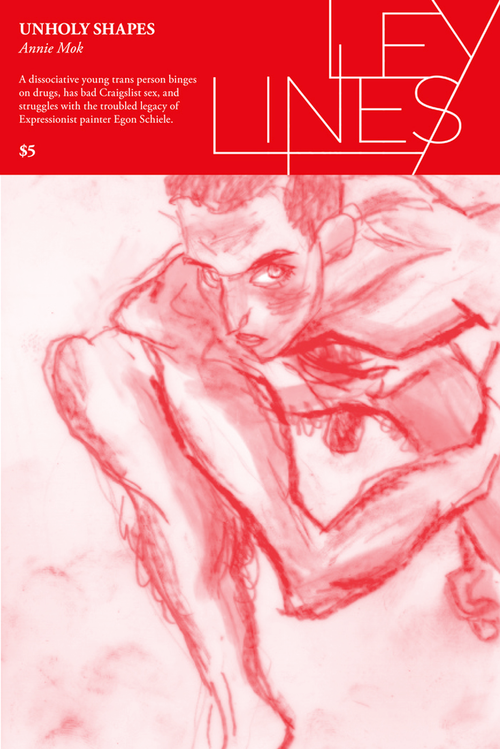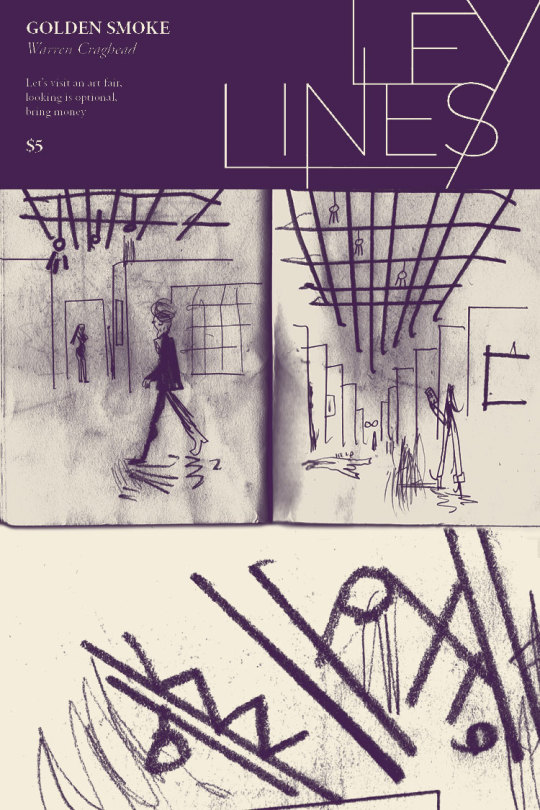
You’ve probably seen me talkabout the Ley Lines series on Twitter. The series is copublished by Czap Books and Grindstone Comics, and the first issue by Annie Mok was on my 2014 Comics that Challenged Me list. Issue #3 by Cathy G. Johnson debuted at TCAF this year, and my review of that comic will go up later this week. I reached out to the series’ co-publishers, Kevin Czap and L. Nichols, to ask a few questions, and they were gracious enough to give some insight on the project.
Sequential State: Could you explain the Ley Lines project for readers?
Kevin Czap: The official description is “a quarterly publication dedicated to exploring the intersection of comics and the various fields of art & culture that inspire us.” Which in practical terms means that every three months, a different cartoonist picks a subject from the larger art culture outside of comics to make a comic about. Every issue shares the same format – size, shape, length – but beyond that, the way each artist chooses to interpret the prompt is up to them. So far, we’ve had Annie Mok, Warren Craghead and Cathy G. Johnson (all powerhouses in their own right), with upcoming issues by Andrew White and Erin Curry to round out our 2015 schedule.

SS: As a whole, what are you trying to achieve with Ley Lines as co-publishers?
L. Nichols: I came into this project with the idea of it being like “fine art fan comics.” I took a lot of media studies classes in college and we talked a lot about fan culture and the idea of appropriation/fan art/fan fiction/etc as a way to engage with media in a
more meaningful way… just a lot of discussions about fans and fan culture and how that all worked. One of my professors, Henry Jenkins, once asked why there weren’t any fine art fan communities. That got me thinking for several years on the topic before spurring me on to make a William Kentridge inspired comic.
As someone who works in both fine art (mixed media paintings, sculptures) and comics, I get frustrated by the lack of dialog and discourse within and between the fields. I was hoping that publishing these comics might help create a different way to engage with and discuss art/culture, particularly the ones that are termed as “fine” or “high” culture.
I feel like museums, theaters and the like as the only “real” way to interact with these certain fields of culture create a barrier to entry – they’re expensive, they are only in certain places, etc. It builds up the feeling of “this isn’t for me” or “this can’t be for me.”
Comics, on the other hand, are reasonably cheap and easy to pass around. You can’t pass a Van Gogh around, but you can pass around a fan comic about him.
I also liked the idea of talking about these big figures in our own medium (comics), on our own turf. It places it on a more even footing and is the inspiration for the name Ley Lines. I wanted these books to be the alignment of power between these two artists/two points. Equals responding to equals.
So I guess what I’m hoping for is an accessible and honest reaction from one artist to another. Something to broaden the dialog in both worlds. Something to acknowledge our feelings about the culture we are surrounded by but often feel separated from.
K: I studied painting at art school, but painting is a medium with a long and varied history. The work I learned about was part of a tradition that had long-since divested material-specificity, so we’re talking about a lot of installations, performance, un-art – descendants of Modernist painting in various ways. The takeaway as it applies to this question is that thinking about art and art-making in critical terms is healthy and important for its growth. What are the boundaries of a medium and why? For as much as you can learn from and iterate on the traditions of a single medium, like painting or comics, what happens when you start introducing outside traditions? As it was posed on the episode of Image Plus Text I did, what can be learned from the wisdom of other media? I strongly believe that cross-pollination between media is to the benefit of all. It’s not just a thought experiment, though – art in
all its forms can be amazing, awe-inspiring and life-changing.
With Ley Lines, I’m hoping we can provide a space for artists to celebrate these connections with the wider culture and, by extension, bring that wider culture into the comics scene. I’m always trying to encourage artists to be true to their individual experience, and as a series of fan art, I really want to see them being as fanatic as they can get. If their thing is Pre-Raphaelite
paintings or Carrie Mae Weems, go all in, share the love!
SS: What brought Czap Books and Grindstone Comics together as a publishing team for this series?
K: Darryl Ayo introduced us at SPX a few years ago, and soon after the three of us were running a blog called
Comix Cube. The whole idea behind Comix Cube was that we wanted to write lengthy pieces about comics that embraced the medium’s place in a larger cultural context. We would often write about our processes through the lens of other art practices, or talk about our influences. Over the years, L and I found that we have a similar worldview, and respond to the same things in comics – poetic sensibilities, a certain reverence, good design. We’ve been looking for a project to collaborate on ever since we each started publishing comics, and finally we just went ahead with it.
L: Yeah, ever since meeting at SPX a few years back we’ve spent a lot of time talking about our work and processes with each other. I think that the Ley Lines project fulfills something we both find missing and wish were there.

SS: Two of the books published so far in the Ley Lines series have been about specific painters, and one about fine arts in
general – do you think the series will stay in the fine art realm, or is there the potential to see intersections between other types of culture?
L: Well, my goal is to do one about Beethoven. So there’s classical music. I’m open to poetry, writers, opera,
architecture, philosophy… basically anything that is seen as part of “high culture” or that exists in a rarefied world that is
(frequently) exclusionary in some regard. Things that you wouldn’t expect to have fans. Things that are seen as stuffy or old or too complicated or too expensive.
K: Yeah, totally. The conversation has hammered into us, but I really don’t put any stock in using terms like high culture. I’d love to see Ley Lines just sidestep that whole conversation and be about comics being an arts culture like the other ones being featured in each issue. There’s a secret, political aspect to that, too – I think it can encourage dismantling oppressive and exclusionary cultural codes that prioritize one group’s experiences and tastes over many others’. Ultimately, the choice of subject is up to the artist, but we do encourage them, again, to “follow their bliss.”

SS: What are your long term goals with a project like Ley Lines?
K: Oh gosh, that’s a tough one! I’m not sure how much we’ve talked about long long term goals. Several amazing artists have expressed interest in the project, and so we have at least two years of really strong work ahead of us with Ley Lines. Beyond that, we’ll have to see. I think one thing we’d both like to see is being able to use Ley Lines as a kind of bridge between the comics and art worlds – putting it in contexts beyond the comics expo. That seems to be in the project’s DNA, you know?
L: I’d love to see Ley Lines being sold/enjoyed/talked about in non-comics circles. The bridge aspect is definitely central to what this is all about. Otherwise, I don’t know that we have specific goals. I’m open to seeing how it grows and letting it become its own thing… maybe like seeds? Pollination? An idea that can land and then sprout up new ideas/art/etc.
Thanks to Kevin and L. for taking the time to answer my questions. You can find out more about the Ley Lines series at its
storenvy page, and find out more about Czap Books and Grindstone Comics at their websites.

One response to “Interview – Kevin Czap and L. Nichols on Ley Lines”
[…] You can find the original interview here. […]